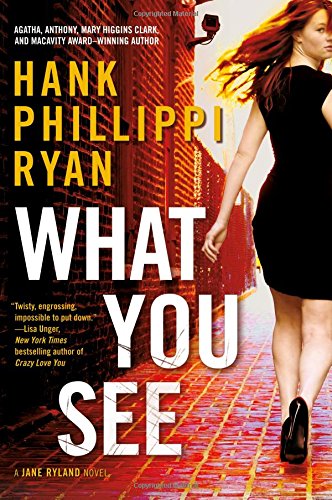 Reviewed by Justin Goodman
Reviewed by Justin Goodman
What You See: A Jane Ryland Novel
by Hank Phillipi Ryan
Series: Jane Ryland (Book 4)
Forge Books
Mass Market Paperback: 320 pages, August 30, 2016, ISBN-13: 978-0765374967
Hank Phillipi Ryan, outside her career as a much-awarded Boston reporter (28 Emmys and 12 Murrow Awards), is among that breed of newshound that pursues news into fiction. At first it was the story of television journalist Charlotte McNally whose luck led her to high stake action and directly into the line of fire. Other than Prime Time, the first book, earning an Agatha Award for best first novel, there was little sound around their publication. It didn’t help they were published by the rarely sounded Harlequin Books. Thankfully, the picture of soft porn that name implies didn’t stay for long and, eventually, Forge Books picked up The Other Woman, the first book of her most recent series about Jane Ryland, a television journalist whose luck leads her to high stake action and directly into the line of fire. And—joking aside—about Jake Brogan, a young detective with the legacy of a police commissioner grandfather to live up to. What You See, the most recent novel of this series is a great summation of everything clever about Ryan’s novels and why she was first published under the Harlequin banner.
In the previous books, Jake and Jane struggled to balance their conflicting work life and love life as they solved mysteries coming to a boil. But it’s helpful to know that this context doesn’t matter: In the tradition of classic detective fiction, they are merely personalities transplanted into different settings; without knowing the previous books, the rare mentions of the previous events are passable. So we have a clean slate when a man is murdered in the daylight of Curley Park, in front of Boston City Hall, and Jane is sent, as a freelancer, to the scene by an eager employer while, at the same time, she’s dealing with the marriage of her sister, Melissa, and Melissa’s possibly missing stepchild, Gracie. Jake, appropriately, shows up at the crime scene, not knowing that Jane is covering the story. Meanwhile, told beside them for, at first, unknown reasons, are Catherine Siskel, her daughter Tenley, and the overeager photographer Bobby Land. Much like the last three novels, What You See perfectly angles each dart of character towards that overwhelming question. Whodunnit? Another bullseye.
It would be if Ryan didn’t go in the direction of Law & Order. Caving in to the pressure of time, the television drama began developing characters that had been strictly hardboiled for a decade. It took “and these are their stories” too literally. Jake and Jane’s relationship in The Other Woman was contained and, for that, thrilling and off-center. By Truth Be Told, two books later, there was rarely a scene where Jane and Jake didn’t think or exclaim the other’s name. Jane—once a professional trying to cope with the impossibilities of her romance—became domesticated. Although the novel was heavily focused on Jake’s family history and his relationship with it, Jake himself became a white knight to Jane with personal struggles torn away. This recent addition to the series furthers this. Most of what’s boiling in What You See is a disastrously stale and smirking passion replacing the boundary that kept the story from too quickly coming together. Instead of five threads woven into whole cloth, there are five threads with a sub-plot as distracting and hideous as a contrast pocket.
While Ryan hasn’t convinced me that there is no suspense in love, no love in suspense, she’s shown she’s less a muckraker than her credentials makes her out to be in her stories focused on political scandal, police corruption, and institutions which create the circumstances for felonious activities. Instead, technology finds itself targeted either explicitly, with each character bemoaning how cameras ruin reality, or implicitly, with offensively wrong metaphors like “her brain was a video game, starting and stopping, fast-forwarding and rewinding” (which makes so little sense that I’m convinced Ryan’s only interaction with video games is from commercials she TiVo’s through). Her always bombastic conspiracies and conclusions force you to see these smaller aspects of the world she overlooks. The villainous behaviors being (often) relegated to men who are counterbalanced by some female Yang. Not quite the grit of Carver or the wit of Christie.
“What you see is what you get,” the idiom from which the title is ripped, is as accurate a summation of What You See as What You See is of Ryan’s writing. The suspense is typical, plot twists predictable, and the characters are as dynamic as the mass printing of the book itself. That doesn’t make it any less enjoyable to read through to the end in the same way, flipping through channels (or browsing Netflix), you may come across a run-of-the-mill show you want to kill time watching. If you wanted something substantial you’d have found it. For a series that at first seemed promising for the layered structure that maintained punchiness against all odds, in Ryan’s new addition, as Tenley succinctly puts it, “The world is the world.”
About the reviewer: Justin Goodman graduated from SUNY Purchase with a B.A. in Literature. Having moved from Long Island, he now lives in the City with reviews in Cleaver Magazine and InYourSpeakers, and work in Italics Mine, 360 Degrees, and Counterexample Poetics.